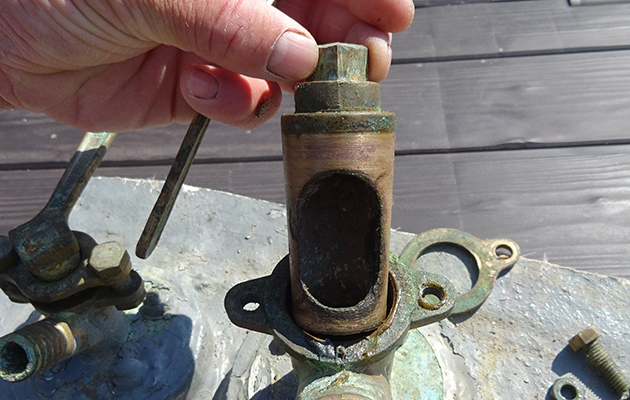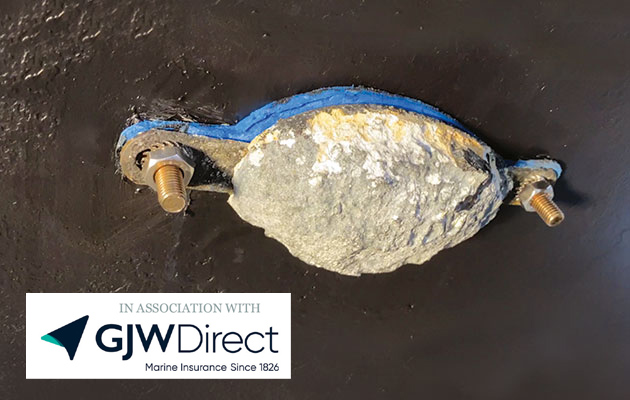After discovering a range of popular misconceptions online, Ben Sutcliffe-Davies explains the importance of fully understanding your seacocks and whether they are fit for purpose
How long should a seacock last?
That was the question posted recently on the Yachting Monthly forum along with recommendations for when to replace them and with what.
There followed about 90 replies, some of which were, in my view, poor advice.

Always carry softwood bungs, with the correct size attached next to each seacock. Credit: Graham Snook/Yachting Monthly
Comments such as ‘the ones with green handles are the best’, ‘just change the valve’, ‘definitely bond them’ or ‘paint them, that stops them corroding’ show the perceptions of what some boat owners think and also concerns me.
It’s worth remembering that what is shiny isn’t necessarily bronze these days! Seacocks are vital, so it is well worth taking the time to understand them fully.
Seacock myths
The handle colours are for identification in domestic plumbing.
Changing the valve alone and bonding DZR brass seacocks aren’t sensible moves either (I’ll cover this a little later).
Painting them may make them look good externally, but has no place in the maintenance of valves.
Frequently when I see failed skin fittings, they have actually broken down from within as the zinc gets stripped out of the alloy.

The handle colours of a seacock are for identification in domestic plumbing, and mean nothing in terms of the quality of the product
It’s not usually the bits you can see where they fail first but where the seacock is passed through the hull or on the shoulders where it is connected.
From the days of J-class yachting, we’ve had British-made bronze gate valves and skin fittings and several types of bronze sluice valve assemblies.
These were fitted in almost every British yacht I can think of built before the 1990s.
Thereafter, the RCD (Recreational Craft Directive) came into force and allowed craft built by bean counters to make savings at the owners’ expense by fitting, cheaper, inferior fittings.

A proper, all-bronze seacock
The fitting of mass-produced brass plumbing products or DZR brass valve assemblies would save about £300 a boat back then.
I remember not understanding how fitting brass or DZR brass with a five-year guarantee was considered acceptable, especially when we were building yachts and fitting bronze tapered valves that have lasted a life-time.
Indeed, many of those boats still have the same bronze valves fitted!
Remember that for well over 100 years we have known that using bronze in the manufacture of yachts is very reliable.
Simply put, bronze is an alloy of copper and tin, where brass is an alloy of copper and up to about 40% zinc, exactly what your anodes are made from!
The issues with the seacock
If any of you attended the 2019 Southampton Boat Show, I presented a daily talk about yacht maintenance on the foredeck stage and highlighted many of the issues with seacocks and what to look for.
The biggest issue with many of the fitted DZR brass valve assemblies isn’t always the actual valve but the machined thickness of the skin fitting walls and hose tails.
Many of these fittings have no obvious markings and could be produced from almost anything!
If the valve doesn’t get regular use then there is a risk the ball valve becomes stiff and then there is a high loading on the skin fitting when it’s used.

A failed seacock can be a disaster. Credit: Graham Snook/Yachting Monthly
Similarly, if hoses aren’t properly supported, the weight of it can be enough to fracture off at the machined shoulder.
Three other risks with seacocks I will briefly cover are: those positioned just below the waterline can become frozen and so the valves themselves split; when fitting the skin fittings, the basic recommendation is that the tail should not be more than 1.5 times the diameter protruding through the hull aperture.
When fitted if this advice is not followed you can cause a shearing issue if the valve seizes or becomes stiff.
Bonding into the craft’s cathodic system is generally considered a bad idea.
The issue with bonding DZR brass valves into a vessel’s cathodic system is that any bonding issues will cause the valves to sacrifice themselves.

When seacocks fail, it is most likely to be where it passes through the hull, as this one has, or at the tail to the attached hose. Credit Graham Snook/Yachting Monthly
So what to check? First, with many ball valves it’s not always easy to identify what they are made of.
There’s a mixture of numbers cast on to some valves that are actually for the thread diameter or water pressure rating in plumbing.
Some DZR brass valves will have CR cast on them for ‘corrosion resistance’ but it wasn’t mandatory to include it.
Whenever talking about seacocks we should also pay homage to the good old Blake Valve.
Until about 30 years ago they were all made in cast bronze and I’ve seen many that are still very serviceable at more than 50 years old!
However, with the costs of production and the competition from inferior competition they started to cast the main components in DZR brass.
I accept that the main casting has a much thicker wall than most DZR brass ball valves, which is an advantage, but I do wish there was enough demand from owners who understand that you only get what you pay for, for them to be able to offer bronze body castings again.

A softwood bung is essential safety kit sufficient to stop a boat sinking. Credit: Graham Snook/Yachting Monthly
In my opinion, they were the best you could buy.
If you have old Blake valves fitted, unless you have a genuinely good reason to replace them, don’t!
Some bronze valves do have small marks on that confirm they are bronze but it’s never consistently clear and can be misleading.
One brass to steer well clear of is Tonval Brass – this is not suitable to ever be used under the water line.

Casting marks provide the clues: A clearly marked bronze body but no mention of what the ball is made of. Be sure to check
There are several reports of craft sinking with these in just a few years.
Over the years I’ve come to the conclusion the best way to look at seacock assemblies is to photograph them and look at the threads.
If there is any obvious corrosion, water leaks or pinkness of the skin fittings or tails then it’s time to change.
The biggest problem with many seacock assemblies is that it only becomes obvious when the valves are removed, and the threads shear off or the hose tail collapses, as to how bad they really were.
Realistically for what they cost, I’d treat them as a consumable and change at five-year intervals.
Alternatives to consider
There are a number of alternatives on the market.
Firstly fitting a proper bronze valve assembly is a good way to go, but confirming what the valve ball is made of is important; some use a chrome coated brass ball.
In the last few years, there have been a few new bronze valves launched, one of which is the Alex valve that is a bronze valve with a composite valve action.
One of the things I pick up regularly online and when surveying, is owners just replace the valve body and ignore the condition of the skin fitting and hose tails.
They are equally likely to fail and should always be replaced.

An Alex valve: One of the latest solutions that has a bronze body and a composite valve
Some older yachts have fabulous quality bronze skin fittings but were initially for gate valves that in most cases had tapered threads; most modern valves are cut as square threads and therefore are actually incompatible to connect to.
I have had an owner yank one off the tail when shutting off before now as they hold on with about three threads if you are lucky.
It must be at least five years since I wrote about the use of composite seacocks in Yachting Monthly, I’ve noticed since then there has been a growing interest in buying them when replacing the old DZR brass.
Some chandleries call them plastic valves in their descriptions, but they are certainly not!
Continues below…
Servicing a Blakes seacock
Keep your Blakes seacocks in top condition with a regular service. Marine surveyor Ben Sutcliffe-Davies shows us how
How to: check and change an anode
Promotional feature in association with GJW Direct. Keeping your anodes in good order prevents serious damage on board, says Rubicon…
Boat maintenance: the 55-point skipper’s checklist
The ultimate boat maintenance checklist to make sure your yacht is ready for launch and the start of the sailing…
Back then I covered in particular the Marelon valves from Forespar who are based in the USA and imported through UK importer Aquafax.

Ben Sutcliffe- Davies has been in the marine industry for over 40 years as a long- time boat builder, has been surveying craft for over 20 years and is a Full Member of the YDSA.
I have a large number of customers who have fitted them over the last 10 years and still look exactly the same as when fitted.
In my own yacht where I have replaced some old DZR brass valves I’ve fitted the Marelon valves without any trauma at all.
It’s also worth knowing that in New Zealand, for over 30 years Trudesign has also manufactured a high-strength composite plastic range of valves that also have ISO compliance.
Some of the modern production yachts have been using composite valves for the holding tanks etc. for a number of years as well.
Whatever you have fitted in the yacht, regular operation and lubrication of any valve is important for reliability.
With either brass or DZR brass, for what they cost it’s not worth the risk of letting them go much past five years.







